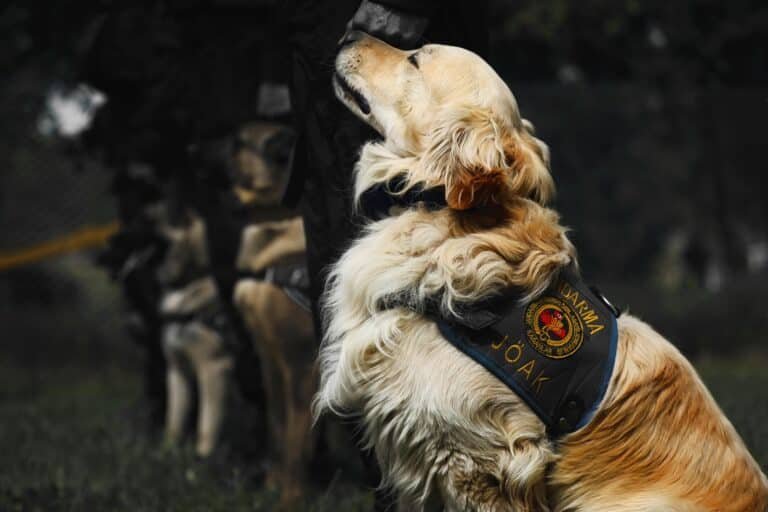
Stay Connected with Us!
Join our communities for the latest updates, tips and earning opportunities:
Introduction: What is Service Dog Training?
Service dog training is a specialized process that prepares dogs to assist individuals with disabilities. These dogs are taught to perform specific tasks that help mitigate the handler’s disability, ranging from physical impairments to emotional support needs. Service dog training is an investment in independence, quality of life, and the safety of individuals with various disabilities.
Table of Contents
ToggleThe Importance of Service Dogs for Individuals with Disabilities
Service dogs provide invaluable assistance to individuals with disabilities, allowing them to live more independently. These dogs help with a wide array of tasks, from providing physical support to detecting medical issues like seizures or low blood sugar. As noted by Service Dog Express, the bond between handler and service dog goes beyond companionship—it’s a life-changing connection that enhances emotional well-being and physical safety
Types of Service Dogs and Their Roles
Service dogs can be trained to assist with various types of disabilities. Common categories include:
- Mobility Assistance Dogs: These dogs assist individuals with limited mobility by opening doors, retrieving objects, or providing stability when walking.
- Medical Alert Dogs: Trained to detect medical issues like seizures, low blood sugar (diabetic alert dogs), or changes in heart rate, these dogs can alert their handlers to potential health emergencies.
- Psychiatric Service Dogs: These dogs support individuals with mental health conditions, such as PTSD, anxiety, and depression. They are trained to provide emotional support and help with symptoms like panic attacks.
- Autism Service Dogs: Specifically trained for children and adults with autism, these dogs help provide emotional comfort and can even help prevent wandering

Understanding the Training Process
Initial Assessments and Customization
The first step in service dog training is an assessment of the dog’s temperament and learning abilities. Not all dogs are suitable for service work, and it’s crucial to choose a dog that can handle the demands of the training. Many organizations, like Total Dog!, offer a free initial evaluation to determine if the dog is a good fit
Types of Disabilities and Training Needs
Service dog training is customized depending on the handler’s needs. Some individuals require more intensive training, such as mobility assistance, while others may need a dog trained to detect seizures. A major part of the process is ensuring the dog is equipped to meet the unique needs of the person they will assist.

Public Access Training: Ensuring Proper Behavior in Public Settings
Public access training is a key component of service dog training. Service dogs must be well-behaved in public spaces, such as restaurants, stores, and airports. They should not be distracted by other animals or situations. Public access training ensures that the dog can work effectively and safely in these environments. Service Dog Express emphasizes that passing a public access test is essential before a dog is considered fully trained
Selecting the Right Dog for Service Dog Training
Not all dogs are cut out for service dog training. The breed, age, and temperament of the dog play a significant role in determining whether they are a suitable candidate. Larger breeds like Labradors and Golden Retrievers are often preferred due to their calm nature and ability to work well with people. However, rescue dogs can also make excellent service dogs if they pass the initial temperament and health assessments
Costs and Financing: Making Service Dog Training Affordable
Service dog training can be expensive, with some programs costing $10,000 or more. However, many organizations work to reduce costs by offering financing options, adopting dogs from shelters, or providing low-cost programs. Service Dog Express is one example of a group that offers affordable training by rescuing dogs from shelters, reducing the overall cost for their clients
Moreover, some service dog programs offer payment plans or even scholarships to help offset costs, making it more accessible for individuals with limited financial resources.

Legal Considerations: Understanding Your Rights and Responsibilities
In the United States, service dogs are protected under the Americans with Disabilities Act (ADA). This law ensures that individuals with disabilities have the right to bring their service dogs into public spaces. However, it’s essential to understand that the ADA only applies to service dogs that are trained to perform specific tasks related to the handler’s disability.
Handlers also have the responsibility to ensure their dog remains under control in public spaces. Dogs must be on a leash or harness, and they should not disrupt the experience of others
Common Myths About Service Dogs
There are several myths about service dogs that need to be debunked:
- Service dogs are just pets: Service dogs are trained to perform tasks that assist individuals with disabilities. They are not pets and should not be treated as such.
- Any dog can be a service dog: Not all dogs are suitable for service work. The dog must have the right temperament, intelligence, and health to be effective in a service role.
- Service dogs don’t need training: Service dogs undergo extensive training to learn how to assist their handlers effectively, behave in public, and perform specific tasks
Conclusion: Changing Lives with Service Dogs
Service dog training not only improves the lives of individuals with disabilities but also gives these animals a second chance at a fulfilling life. Whether you are considering training your dog or adopting a trained service dog, the benefits are immense. Trained service dogs are invaluable companions and helpers for those with physical and mental challenges, making a difference in ways words can’t describe.
Service Dog Express – Learn more about service dog training and the various services they offer to help individuals with disabilities.
FAQ's
1. What is the difference between a service dog and an emotional support dog?
A service dog is trained to perform specific tasks that assist a person with a disability, such as guiding a person with blindness, alerting someone with a seizure disorder, or providing mobility support. Service dogs are protected under the Americans with Disabilities Act (ADA), which allows them to accompany their handlers in public places.
An emotional support dog provides comfort through companionship but is not trained to perform tasks. While emotional support animals can be beneficial, they do not have the same public access rights as service dogs
2. How long does it take to train a service dog?
The training process for a service dog typically takes 18 months to 2 years. This includes basic obedience training followed by specific task training for the individual’s needs. The dog must also undergo public access training to ensure it behaves appropriately in public spaces
3. Can any dog become a service dog?
Not every dog is suitable for service dog training. The ideal service dog is calm, intelligent, and able to stay focused in public settings. While breeds like Labradors and Golden Retrievers are often chosen for their temperament, rescued dogs can also be trained as service dogs, provided they pass a temperament assessment
4. Are there any financial assistance options for service dog training?
Yes, there are several financial assistance programs available for those who cannot afford the full cost of service dog training. Some organizations offer payment plans, scholarships, or use rescued dogs to lower the overall cost. You can also check with local service dog organizations, as many offer fundraising or financial aid programs
5. What tasks can a service dog perform?
Service dogs can be trained to perform a wide variety of tasks depending on the individual’s disability. Some examples include:
- Guiding visually impaired individuals
- Alerting to medical conditions like seizures or low blood sugar
- Providing mobility assistance by retrieving items or opening doors
- Psychiatric support for those with mental health disorders like PTSD




